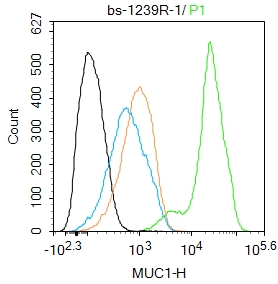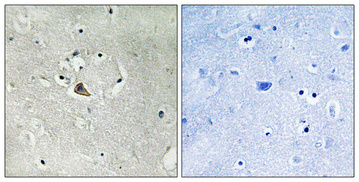MUC1 antibody
GTX100459
ApplicationsImmunoFluorescence, ImmunoPrecipitation, Western Blot, ImmunoCytoChemistry, ImmunoHistoChemistry, ImmunoHistoChemistry Paraffin
Product group Antibodies
TargetMUC1
Overview
- SupplierGeneTex
- Product NameMUC1 antibody
- Delivery Days Customer9
- Application Supplier NoteWB: 1:500-1:3000. ICC/IF: 1:100-1:1000. IHC-P: 1:100-1:1000. IP: 1:100-1:500. *Optimal dilutions/concentrations should be determined by the researcher.Not tested in other applications.
- ApplicationsImmunoFluorescence, ImmunoPrecipitation, Western Blot, ImmunoCytoChemistry, ImmunoHistoChemistry, ImmunoHistoChemistry Paraffin
- CertificationResearch Use Only
- ClonalityPolyclonal
- Concentration0.35 mg/ml
- ConjugateUnconjugated
- Gene ID4582
- Target nameMUC1
- Target descriptionmucin 1, cell surface associated
- Target synonymsADMCKD, ADMCKD1, ADTKD2, CA 15-3, CD227, Ca15-3, EMA, H23AG, KL-6, MAM6, MCD, MCKD, MCKD1, MUC-1, MUC-1/SEC, MUC-1/X, MUC1/ZD, PEM, PEMT, PUM, mucin-1, H23 antigen, breast carcinoma-associated antigen DF3, cancer antigen 15-3, carcinoma-associated mucin, episialin, krebs von den Lungen-6, mucin 1, transmembrane, peanut-reactive urinary mucin, polymorphic epithelial mucin, tumor associated epithelial mucin, tumor-associated epithelial membrane antigen
- HostRabbit
- IsotypeIgG
- Protein IDP15941
- Protein NameMucin-1
- Scientific DescriptionThis gene is a member of the mucin family and encodes a membrane bound, glycosylated phosphoprotein. The protein is anchored to the apical surface of many epithelia by a transmembrane domain, with the degree of glycosylation varying with cell type. It also includes a 20 aa variable number tandem repeat (VNTR) domain, with the number of repeats varying from 20 to 120 in different individuals. The protein serves a protective function by binding to pathogens and also functions in a cell signaling capacity. Overexpression, aberrant intracellular localization, and changes in glycosylation of this protein have been associated with carcinomas. Multiple alternatively spliced transcript variants that encode different isoforms of this gene have been reported, but the full-length nature of only some has been determined. [provided by RefSeq]
- Storage Instruction-20°C or -80°C,2°C to 8°C
- UNSPSC12352203
References
- Chang YX, Lin YF, Chen CL, et al. Chaperonin-Containing TCP-1 Promotes Cancer Chemoresistance and Metastasis through the AKT-GSK3β-β-Catenin and XIAP-Survivin Pathways. Cancers (Basel). 2020,12(12). doi: 10.3390/cancers12123865Read this paper
- Souris JS, Zhang HJ, Dougherty U, et al. A novel mouse model of sporadic colon cancer induced by combination of conditional Apc genes and chemical carcinogen in the absence of Cre recombinase. Carcinogenesis. 2019,40(11):1376-1386. doi: 10.1093/carcin/bgz050Read this paper







